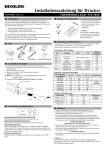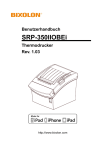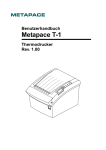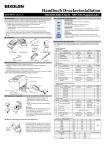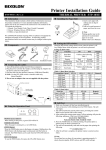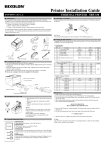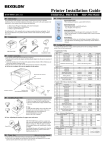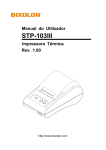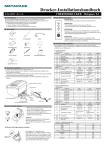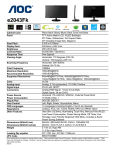Download Installationsanleitung für Drucker
Transcript
Installationsanleitung für Drucker THERMODRUCKER STP-103III KN04-00096C (Rev.1.1) ◈ Information ◈ Einlegen der Papierrolle Diese Installationsanleitung enthält eine kurze Beschreibung der nötigen Informationen für die Produktinstallation. Für detailliertere Informationen zur Installation wird auf das Benutzerhandbuch auf der beiliegenden CD verwiesen. Die CD enthält folgende Inhalte. 1. Legen Sie eine neuePapierrolle ein und richten Sie sie richtig aus. 2. Ziehen Sie etwas Papier heraus und schließen Sie die Abdeckung. 1. Handbuch: Benutzerhandbuch, Code-Tabelle, Steuerbefehle 2. Treiber: Windows-Treiber, OPOS-Treiber 3. Dienstprogramme: ein Download-Tool für Logos Wir von BIXOLON arbeiten ständig an Verbesserungen und Aktualisierungen der Funktionen und der Qualität aller unserer Produkte. Die Produktspezifikationen und/oder der Inhalt des Benutzerhandbuchs können sich in der Zukunft ohne vorherige Ankündigung ändern. ◈ Teile Procuct Installation CD ※ HINWEIS Wird nicht das empfohlene Papier verwendet, kann es zu Einbußen in der Druckqualität kommen (siehe Benutzerhandbuch). ◈ Einstellen der DIP-Schalter Änderungen der DIP-Schaltereinstellungen können nur vorgenommen werden, wenn der Drucker ausgeschaltet ist. Bei eingeschaltetem Drucker vorgenommene Änderungen werden nicht verarbeitet. Einstellen des DIP-Schalters Kabel STP-103III Papierrolle Netzteil Stromkabel CD Installationsanleitung SW SW 1-1 SW 1-2 SW 1-3 SW 1-4 SW 1-5 ◈ Anschließen der Kabel SW 1-6 1. Schalten Sie den Drucker und den Host-ECR (Host-Computer) aus. 2. Stecken Sie das Stromkabel in das Netzteil und verbinden Sie das Netzteil anschließend mit dem Netzanschluss am Drucker. 3. Stecken Sie das Kabel in den Schnittstellenanschluss ein. (USB/Seriell/ Parallel) ※ Hinweis: Verwenden Sie nur das Schnittstellenkabel des STP-103III. (Seriell/ Parallel) ※ Nur den im Lieferumfang enthaltenen Adapter verwenden. SW 1-7 SW 1-8 Schnittstellenanschluss Schnittstellenkabel (Seriell/Parallel) EIN Stromkabel Netzteil * Siehe folgende Tabelle 1 Dichte Handschlag Zeichen pro Zeile (Schrift A) Schriftauswahl Schriftauswahl Dunkel Normal Xon / Xoff DTR/DSR 24 Zeichen 32 Zeichen pro Zeile pro Zeile Schrift B/Ba Schrift A * Siehe folgende Tabelle 2 [Tabelle1] Auswahl der Baud-Rate Übertragungsge SW 1-1 SW 1-2 schwindigkeit SW 1-3 2400 Baud 4800 Baud EIN AUS AUS EIN AUS AUS 9600 Baud AUS AUS EIN 19200 Baud 38400 Baud 57600 Baud 115200 Baud EIN EIN AUS EIN AUS EIN EIN EIN EIN AUS EIN EIN Default (Standard) AUS AUS EIN AUS AUS AUS AUS AUS Bemerkung Default (Standard) SW 1-8 Bemerkung Default (Standard) Schrift A (12x24) AUS AUS Schrift B (9x17) Schrift C (9x24) Reserviert EIN AUS EIN AUS EIN EIN ◈ Selbsttest ◈ Verwendung des Bedienfeldes FEED AUS Auswahl der Baud-Rate [Tabelle 2] Schriftauswahl Schriftgröße SW 1-7 USB-Kabel DK-Port POWER ERROR Funktion ON LINE • POWER (ANZEIGE FÜR EIN/AUS, GRÜNE LED) Beim Einschalten des Stroms leuchtet eine grüne LED auf. • ERROR (FEHLERANZEIGE, ROTE LED) Wenn nur noch wenig Papier im Drucker ist, blinkt eine rote LED. • FEED (Papierzufuhr-Taste) Drücken Sie einmal auf die FEED-Taste, um zusätzliches Papier zuzuführen. Wenn Sie die FEED-Taste gedrückt halten, wird so lange Papier zugeführt, bis Sie die Taste wieder loslassen. Die FEED-Taste kann nur bei ausgeschalteter ONLINE-Taste verwendet werden. • ON LINE (ON-LINE-Taste) Drücken Sie zur Verwendung der FEED-Taste erst einmal auf die ON-LINETaste. 1. Achten Sie darauf, dass die Papierrolle richtig eingelegt wurde. 2. Schalten Sie den Drucker ein und halten Sie dabei die Taste FEED (Papierzufuhr) gedrückt. Der Selbsttest beginnt. 3. Der Selbsttest druckt den aktuellen Druckerstatus aus. Darin werden die Steuerungs-ROM-Version und die DIP-Schaltereinstellungen ausgewiesen. 4. Nach dem Drucken des aktuellen Druckerstatus druckt der Selbsttest folgende Information aus und hält an. (DieError-LED (Fehleranzeige) blinkt.) SELBSTTESTDRUCK: DRÜCKEN SIE AUF DIE FEED-TASTE. 5. Drücken Sie auf die FEED-Taste, um den Druck fortzusetzen. Der Drucker druckt ein Muster mit dem eingebauten Zeichensatz aus. 6. Der Selbsttest endet automatisch und das Papier wird nach dem Ausdrucken der folgenden Meldung abgeschnitten. *** ABGESCHLOSSEN *** 7. Im Anschluss an den Selbsttest wechselt der Drucker wieder in den normalen Online-Status. ※ Hinweis Mit dem Selbsttest können Sie ermitteln, ob Ihr Drucker ordnungsgemäß funktioniert. Bei dem Test werden die Druckqualität, die ROM-Version und die DIP-Schaltereinstellungen geprüft. ◈ Spezifikationen Komponente Details Druckmethode Punktdichte Druckbreite Zeichen pro Zeile Druckgeschwindigkeit *1) Drucker Empfangspuffergröße SMPS Eingangsspannung Thermozeilendruck 203 dpi (8 Punkte/mm) 48mm 32 (Schrift A: 12x24) 42 (Schrift B: 9x17 / Schrift C: 9x24) Ca. 3,15 Zoll/s 80 mm/s um 25℃/Drucklast 12,5 % 64 Kbytes 100-240 VAC Temperatur Umgebungsbedingungen Luftfeuchtigkeit MCBF *2) Papier Papierbreite Papierstärke Rollen-Durchmesser Papierwalze 5-40℃ (Betrieb) -10-+50℃ (Lagerung) 30-80 % (Betrieb) 10-90 % (Lagerung) 30.000.000 Zeilen 100 km Mechanismus Kopf 57,5±0,5mm Papierstärke: 0,062-0,075 mm Ø60 mm Innen: Ø12mm (0,47") Außen: Ø18mm (0,71") ※ Hinweis *1) Die Druckgeschwindigkeit kann langsamer ausfallen, je nach der Datenübertragungsgeschwindigkeit und der Kombination der Steuerbefehle. *2) Dieser Wert wird für einen bestimmten Zustand gemessen, zum Beispiel Standardtemperatur, angegebenes Papier und Standarddruckdichte, und er kann sich je nach der Temperatur oder dem Druckvolumen ändern. ◈ Windows-Modell mit fester, serieller Schnittstelle (RS-232C) 1. Führen Sie die Datei Software_STP-103III_Windows_Driver_Vx.x.x.exe aus. 2. Das Installationsfenster wird geöffnet. Klicken Sie hier auf „Next“ (Weiter). 3. Wählen Sie im Fenster „Port Type“ (Anschlusstyp) die Option „Serial Port“ (Serieller Anschluss) aus und klicken dann auf „Next“ (Weiter). 7. Wählen Sie im Fenster „Properties“ (Eigenschaften) die Registerkarte „General“ (Allgemein) aus und klicken Sie auf „Print Test Page“ (Testseite drucken), um den normalen Druckbetrieb zu bestätigen. ◈ Windows-Modell mit fester paralleler Schnittstelle (IEEE1284) 1. Führen Sie die Datei Software_STP-103III_Windows_Driver_Vx.x.x.exe aus. 2. Das Installationsfenster wird geöffnet. Klicken Sie hier auf „Next“ (Weiter). 3. Wählen Sie im Fenster „Port Type“ (Anschlusstyp) die Option „Parallel Port“ (Paralleler Anschluss) aus und klicken Sie dann auf „Next“ (Weiter). 4. Klicken Sie auf „Yes“. Der Computer wird neu gestartet. 5. Öffnen Sie nach Neustart des Computers das Fenster „Printer Properties“ (Druckereigenschaften). ※ XP oder Server 2003: Control Panel (Systemsteuerung) > Printers and Faxes (Drucker und Faxgeräte) ※ Vista oder aktueller: Control Panel (Systemsteuerung) > Hardware and Sound (Hardware und Ton) > Devices and Printers (Geräte und Drucker) 6. Wählen Sie im Fenster „Properties“ (Eigenschaften) die Registerkarte „General“ (Allgemein) aus und klicken Sie auf „Print Test Page“ (Testseite drucken), um den normalen Druckbetrieb zu bestätigen. ◈ Windows-Modell mit fester USB-Schnittstelle 1. Führen Sie die Datei Software_STP-103III_Windows_Driver_Vx.x.x.exe aus. 2. Das Installationsfenster wird geöffnet. Klicken Sie hier auf „Next“ (Weiter). 3. Wählen Sie im Fenster „Port Type“ (Anschlusstyp) die Option „USB“ aus und klicken dann auf „Next“ (Weiter). 4-1. Windows Vista, Server 2008, 7, 8 oder Server 2012: Schalten Sie den Drucker aus- und wieder an. Der Treiber wird automatisch installiert. 4-2. Windows XP oder Server 2003: Schalten Sie den Drucker aus- und wieder an. Wenn das Fenster „New Hardware Detected“ (Neue Hardware gefunden) angezeigt wird, klicken Sie auf „Next“ (Weiter), um den Treiber zu installieren. ※ Hinweis: Sollte während der Installation eine Warnung angezeigt werden, klicken Sie entweder auf „Continue Anyway“ (Dennoch fortfahren) oder auf „Install“ (Installieren) 5. Öffnen Sie nach Neustart des Computers das Fenster „Printer Properties“ (Druckereigenschaften). ※ XP oder Server 2003: Control Panel (Systemsteuerung) > Printers and Faxes (Drucker und Faxgeräte) ※ Vista oder aktueller: Control Panel (Systemsteuerung) > Hardware and Sound (Hardware und Ton) > Devices and Printers (Geräte und Drucker) ◈ WEEE (Elektroschrott) (Abbildung 1) 4. Klicken Sie auf „Yes“. Der Computer wird neu gestartet. 5. Öffnen Sie nach Neustart des Computers das Fenster „Printer Properties“ (Druckereigenschaften). ※ XP oder Server 2003: Control Panel (Systemsteuerung) > Printers and Faxes (Drucker und Faxgeräte) ※ Vista oder aktueller: Control Panel (Systemsteuerung) > Hardware and Sound (Hardware und Ton) > Devices and Printers (Geräte und Drucker) 6. Wählen Sie im Fenster „Properties“ (Eigenschaften) die Registerkarte „Port“ (Anschluss) aus und klicken Sie auf „Port Settings“ (Anschlusseinstellungen). Prüfen Sie, ob die Informationen denen der Ergebnisse des nach der Installation abgeschlossenen Selbsttests entsprechen und klicken Sie auf „OK“. Diese Kennzeichnung auf dem Produkt oder der Produktdokumentation weist darauf hin, dass das Produkt nicht über den Hausmüll entsorgt werden sollte. Um eventuelle Umwelt- oder Gesundheitsschäden aufgrund der unsachgemäßen Entsorgung zu vermeiden, sollten Sie dieses Produkt von anderen Abfällen trennen und recyceln. So fördern Sie den nachhaltigen Gebrauch der Ressourcen. Wenn Sie das Produkt in Ihrem Haushalt benutzen, wenden Sie sich bitte an Ihren Fachhändler, bei dem Sie das Produkt gekauft haben, oder an die Stadtverwaltung. Dort können Sie Einzelheiten dazu erfragen, wie und wo Sie dieses Produkt abgeben können, damit es umweltsicher recycelt wird. Wenn Sie das Produkt in der Firma benutzen, sollten Sie sich an Ihren Zulieferer wenden und die entsprechenden Bedingungen über die Rücknahme oder Entsorgung im Kaufvertrag nachlesen. Dieses Produkt sollte nicht zusammen mit anderen gewerblichen Abfällen entsorgt werden. ☎ BIXOLON Co., Ltd. ● Website http://www.bixolon.com ● Hauptbüro in Korea (Adresse) 7~8F, (Sampyeong-dong), 20, Pangyoyeok-ro241beon-gil, Bundang-gu, Seongnam-si, Gyeonggi-do, 463-400, Korea (ROK) (Telefon) +82-31-218-5500 ● Büro in den USA (Adresse) BIXOLON America Inc., 3171 Fujita St, Torrance, CA 90505 (Telefon) +1-858 764 4580 ● Zweigstelle für Europa (Adresse) BIXOLON Europe GmbH, Tiefenbroicher Weg 35 40472 Düsseldorf (Telefon) +49 (0)211 68 78 54 0 (Abbildung 2) Guía de instalación de la impresora IMPRESORA TÉRMICA STP-103III ◈ Información ◈ Cómo instalar el rollo de papel Esta Guía de instalación incluye un breve resumen de la información necesaria para la instalación del producto. Para obtener información de instalación más detallada, consulte el manual del usuario que se encuentra en el CD adjunto. Los contenidos del CD incluyen lo siguiente. 1. Manual: Manual del usuario, Tabla de códigos, Comandos de control 2. Controladores: Controladores para Windows, controladores OPOS 3. Programas utilitarios: herramienta para descarga de logos 1. Inserte un nuevo rollo de papel, asegurándose de alinearlo adecuadamente. 2. Quite una pequeña cantidad de papel y cierre la tapa. ※ NOTA La calidad de la impresión puede no ser óptima si no se utiliza el papel recomendado. (Consulte el Manual del usuario.) En BIXOLON mantenemos esfuerzos continuos para mejorar y actualizar las funciones y la calidad de todos nuestros productos. En lo sucesivo, las especificaciones del producto y/o el contenido del manual del usuario pueden modificarse sin previo aviso. ◈ Cómo configurar los interruptores DIP ◈ Componentes Procuct Installation CD Cable STP-103III Rollo de papel Adaptador AC/DC Cable de energía CD Guía de instalación Para cambiar la configuración de los interruptores DIP, la impresora debe estar apagada. Los cambios que se realicen mientras la impresora esté encendida no se procesarán. Cómo configurar el interruptor DIP SW Function SW 1-1 SW 1-2 SW 1-3 SW 1-4 Selección de velocidad de transmisión Densidad Entrada en comunicación Caracteres por línea (Fuente A) Selección de Fuente SW 1-5 ◈ Cómo conectar los cables 1. Apague la impresora y la caja registradora principal (computadora principal). 2. Conecte el cable de energía al adaptador, y luego, el adaptador al conector de alimentación de la impresora. 3. Conecte el cable al conector interfaz. (USB/Serie/ Paralelo) ※ Nota: Sólo use el cable interfaz exclusivo de la STP-103III. (Serie/ Paralelo) ※ No utilice un adaptador que no haya sido provisto junto con la impresora. Conector interfaz Cable interfaz (Serie/Paralelo) SW 1-6 SW 1-7 SW 1-8 ENCENDIDO Normal Predeter minado APAGADO APAGADO ENCENDIDO APAGADO DTR/DSR APAGADO APAGADO * Consulte la siguiente tabla 1 Oscuro Xencendido /Xapagado 24 CPL 32 CPL APAGADO * Consulte la siguiente tabla 2 APAGADO APAGADO [Tabla 1] Selección de velocidad de transmission Velocidad de transmisión 2400 Baudios 4800 Baudios SW 1-1 SW 1-2 SW 1-3 ENCENDIDO APAGADO APAGADO ENCENDIDO APAGADO APAGADO 9600 Baudios APAGADO APAGADO ENCENDIDO 19200 Baudios 38400 Baudios 57600 Baudios 115200 Baudios ENCENDIDO ENCENDIDO APAGADO ENCENDIDO APAGADO ENCENDIDO ENCENDIDO ENCENDIDO ENCENDIDO APAGADO ENCENDIDO ENCENDIDO Comen tario Predet Ermi nado [Tabla 2] Selección de Fuente Cable USB Puerto DK Cable de energía Adaptador AC Medida de fuente Fuente A (12x24) Fuente B (9x17) Fuente C (9x24) Reservado SW 1-7 APAGADO ENCENDIDO APAGADO ENCENDIDO SW 1-8 APAGADO APAGADO ENCENDIDO ENCENDIDO Comentario PredetErminado ◈ Autoevaluación ◈ Cómo usar el panel de funcionamiento POWER ERROR FEED ON LINE • POWER (LED, VERDE) Cuando conecte la energía, se encenderá un LED verde. • ERROR (LED, ROJO) Cuando el papel está por terminarse, un LED rojo parpadea. • FEED (Botón) Presione una vez el botón de FEED para expulsar más papel. Si mantiene presionado el botón de FEED, descargará papel continuamente hasta que lo suelte. El botón de FEED se puede usar cuando está apagado el botón de ON LINE. • ON LINE (Botón) Para usar el botón de FEED, primero presione una vez el botón de ON LINE. 1. Asegúrese de que el rollo de papel haya sido instalado adecuadamente. 2. Encienda la impresora mientras mantiene presionado el botón de ALIMENTACIÓN. Comienza la autoevaluación. 3. Esta función imprime el estado actual de la impresora, proporciona la versión ROM de control y la configuración de los interruptores DIP. 4. Luego, la autoevaluación imprimirá lo siguiente y hará una pausa. (La luz LED de Error parpadea). IMPRESIÓN DE AUTOEVALUACIÓN. PRESIONE EL BOTÓN DE ALIMENTACIÓN 5. Presione el botón de ALIMENTACIÓN para continuar con la impresión. La impresora imprime un dibujo usando el conjunto de caracteres incorporado. 6. La autoevaluación termina automáticamente y corta el papel después de imprimir lo siguiente. *** FINALIZADO *** 7. Una vez finalizado el proceso, la impresora regresa al estado normal en línea. ※ Nota La autoevaluación le permite saber si su impresora funciona correctamente. Comprueba la calidad de impresión, la versión ROM y la configuración de los interruptores DIP. ◈ Especificaciones Elemento Método de impresión Densidad del punto Ancho de impresión Caracteres por línea Impresora Papel Velocidad de impresión *1) Detalles Impresión térmica por línea 203 Dpi (8 puntos/mm) 48 mm 32 (Fuente A : 12x24) 42 (Fuente B : 9x17 / Fuente C : 9x24) Aproximadamente 3,15 pulgadas/seg 80 mm/seg a 25℃/tarea de impresión 12,5% Tamaño del búfer 64K bytes de recepción SMPS Tensión de 100 ~ 240 VAC entrada 0 ~ 45℃ (Funcionamiento) Temperatura Condiciones -20 ~ 60℃ (Almacenamiento) ambientales 10 ~ 80% HR(Funcionamiento) Humedad 10 ~ 90% HR (Almacenamiento) Mecanismo 30.000.000 líneas MCBF *2) Cabezal 50 km Ancho del papel 57,5±0,5mm Espesor del papel Espesor del papel : 0,062 ~ 0,075mm Diámetro del rollo Ø60 mm Interior : Ø12 mm (0,47”) Tubo del papel Exterior : Ø18 mm (0,71”) ※ Nota *1) La velocidad de impresión puede ser más lenta según la velocidad de transmisión de datos y la combinación de los comandos de control. *2) Este valor se mide para una determinada condición tal como temperatura estándar, papel especificado y densidad estándar de impresión y puede cambiar dependiendo del nivel de la temperatura o la impresión. ◈ Instalación de los controladores de Windows del modelo de interfaz serie fijo (RS-232C) 1. Ejecutar el el archivo de Software_STP-103III_de los controlador de Windows_Vx.x.x.exe. 2. En la ventana que se abra para la instalación, haga clic en Siguiente.. 3. En la ventana Tipo de puerto, seleccionar un Puerto serie y hacer clic en Siguiente. 7. En la ventana Propiedades, seleccionar la pestaña General y hacer clic en Imprimir página de prueba para confirmar que la impresión sea normal. . ◈ Instalación de los controladores de Windows del Modelo de interfaz paralela fija (IEEE1284) 1. Ejecutar el archivo de Software_STP-103III_de los controlador de Windows_Vx.x.x.exe. 2. En la ventana que se abra para la instalación, haga clic en Siguiente.. 3. En la ventana Tipo de puerto, seleccionar un Puerto paralelo y hacer clic en Siguiente. 4. Haga clic en Sí y la computadora se reiniciará. 5. Luego que la computadora se haya reiniciado, abra la ventana Propiedades de impresora. ※ Servidor XP o 2003: Panel de control > Impresoras y faxes ※ Vista o versiones anteriores: Panel de control > Hardware y sonido > Dispositivos e impresoras 6. En la ventana Propiedades, seleccionar la pestaña General y hacer clic en Imprimir página de prueba para confirmar que la impresión sea normal. ◈ Instalación de los controladores de Windows del modelo de interfaz USB 1. Ejecutar el archivo de Software_STP-103III_de los controlador de Windows_Vx.x.x.exe. 2. En la ventana que se abra para la instalación, haga clic en Siguiente.. 3. En la ventana Tipo de puerto, seleccionar USB y hacer clic en Siguiente. 4-1. Si utiliza Windows Vista, Servidor 2008, 7, 8, o Servidor 2012: Apague la impresora y vuelva a encenderla. El controlador se instala automáticamente. 4-2. Si utiliza Windows XP o Servidor 2003: Apague la impresora y vuelva a encenderla. Cuando aparezca la ventana Nuevo hardware encontrado, siga haciendo clic en Siguiente para instalar el controlador. ※ Nota: Si aparece una casilla de mensaje de advertencia durante la instalación, haga clic en Continuar de todas maneras o Instalar. 5. Luego que la computadora se haya reiniciado, abra la ventana Propiedades de impresora. ※ Servidor XP o 2003: Panel de control > Impresoras y faxes ※ Vista o versiones anteriores: Panel de control > Hardware y sonido > Dispositivos e impresoras 6. En la ventana Propiedades, seleccionar la pestaña General y hacer clic en Imprimir página de prueba para confirmar que la impresión sea normal ◈ WEEE (Waste Electrical and Electric Equipment) (Figura 1) 4. Haga clic en Sí y la computadora se reiniciará. 5. Luego que la computadora se haya reiniciado, abra la ventana Propiedades de impresora. ※ Servidor XP o 2003: Panel de control > Impresoras y faxes ※ Vista o versiones anteriores: Panel de control > Hardware y sonido > Dispositivos e impresoras 6. En la ventana Propiedades, seleccionar la pestaña Puerto y hacer clic en Configuración de puerto. Compruebe que la información sea idéntica a los resultados de la autoevaluación realizada después de la instalación y haga clic en OK. . Esta marca mostrada sobre el producto, indica que este no debería ser mezclado junto con otros desechos de uso doméstico al final de su vida laboral. Para prevenir el posible daño medioambiental o de salud humana en la recogida de basura incontrolada, por favor separe este producto de otros tipos de desechos y recíclelo con responsabilidad para promover la reutilización de recursos materiales. El usuario final del producto debería ponerse en contacto con el distribuidor donde ha realizado la compra del producto, ó con su oficina de administración local, para que le informen dónde y cómo ellos pueden hacer el reciclaje ecológico seguro y adecuado. Los empresarios deberían ponerse en contacto con su proveedor y comprobar los términos y las condiciones del contrato de compra. Este producto no debería ser mezclado con otros desechos comerciales. ☎ BIXOLON Co., Ltd. ● Sitio Web http://www.bixolon.com ● Oficinas centrales en Corea (Dir.) 7~8F, (Sampyeong-dong), 20, Pangyoyeok-ro241beon-gil, Bundang-gu, Seongnam-si, Gyeonggi-do, 463-400, Korea (ROK) (Tel.) +82-31-218-5500 ● Oficina en los EE.UU. (Dir.) BIXOLON America Inc., 3171 Fujita St, Torrance, CA 90505 (Tel.) +1-858 764 4580 ● Oficina en Europa (Dir.) BIXOLON Europe GmbH, Tiefenbroicher Weg 35 40472 Düsseldorf (Figura 2) (Tel.) +49 (0)211 68 78 54 0 Guide d’installation de l’imprimante IMPRIMANTE THERMIQUE STP-103III ◈ Information ◈ Installation du rouleau de papier Ce guide d’installation comprend de brèves informations nécessaires à l'installation du produit. Pour des informations plus détaillées concernant l’installation, veuillez vous reporter au manuel d’utilisation disponible sur le CD fourni. Le contenu du CD est le suivant : 1. Manuel : Manuel d’utilisation, schéma des codes, commandes de contrôle 2. Pilotes : Pilotes Windows, pilotes Système d’exploitation 3. Utilitaires : Un outil de téléchargement de logo Nous, BIXOLON, poursuivons sans cesse nos efforts afin d’améliorer et de mettre à jour les fonctions et la qualité de tous nos produits. Dans le présent manuel, les caractéristique et / ou le contenu du manuel d’utilisation peut être modifié sans avis préalable. ◈ Composants Procuct Installation CD STP-103III Câble Rouleau de papier CD Adaptateur CA/CC Cordon d’alimentation Guide d’installation ◈ Connexion des câbles 1. Eteindre l'imprimante ainsi que la caisse enregistreuse électronique hôte (ordinateur hôte). 2. Brancher le cordon d'alimentation dans l'adaptateur, puis, brancher l'adaptateur dans la prise d'alimentation de l'imprimante. 3. Brancher le câble dans le connecteur de l’interface. (USB/Série/ Parallèle) ※ Note Utiliser uniquement le câble d’interface STP-103III. (Série/ Parallèle) ※ Ne pas utiliser d'adaptateur non fourni avec l'imprimante. Connecteur d’interface Câble d’interface (Série / Parallèle) Câble USB Port DK Cordon d’alimentation Adaptateur CA ◈ Utilisation du panneau de fonctions POWER ERROR FEED ON LINE • POWER (LED, GREEN) Lorsque l'imprimante est allumée, un voyant vert s'allume. • ERROR (VOYANT, ROUGE) Lorsqu’il n’y a presque plus de papier, le voyant rouge clignote. • FEED (Bouton) Appuyer une fois sur le bouton FEED pour retirer le surplus de papier. Appuyer sur le bouton FEED jusqu’à ce que tout le surplus du papier soit dégagé. Le bouton FEED peut être utilise lorsque le bouton ON LINE est éteint. • ON LINE (Bouton) Appuyer une fois sur le bouton ON LINE pour utiliser le bouton FEED. 1. Insérer un nouveau rouleau de papier et s’assurer qu’il est correctement aligné. 2. Sortir une petite quantité de papier puis refermer le couvercle. ※ Remarque La qualité d'impression peut ne pas être optimale si un papier autre que celui recommandé est utilisé. (Se reporter au manuel d'utilisateur.) ◈ Paramétrage des commutateurs DIP La modification des paramètres des commutateurs DIP doit être effectuée lorsque l’imprimante est éteinte. Toute modification effectuée lorsque l’imprimante est allumée ne sera pas traitée. Paramétrage du commutateur DIP SW Fonction ON OFF Défaut SW 1-1 OFF Sélection du * Se reporter au tableau 1 SW 1-2 OFF débit en bauds suivant SW 1-3 ON SW 1-4 Densité Noire Normale OFF SW 1-5 Prise de contact Xon / Xoff DTR/DSR OFF Caractère par SW 1-6 24 CPL 32 CPL OFF ligne (Police A) SW 1-7 OFF Sélection des * Se reporter au tableau 2 polices suivant SW 1-8 OFF [Tableau 1] Sélection du débit en bauds Vitesse de SW 1-1 SW 1-2 SW 1-3 Remarque transmission 2400 Bauds ON OFF OFF 4800 Bauds OFF ON OFF 9600 Bauds OFF OFF ON Défaut 19200 Bauds ON OFF ON 38400 Bauds ON ON OFF 57600 Bauds OFF ON ON 115200 Bauds ON ON ON [Tableau 2] Sélection des polices Taille Police SW 1-7 SW 1-8 Remarque Police A (12x24) OFF OFF Défaut Police B (9x17) ON OFF Police C (9x24) OFF ON Réservé ON ON ◈ Autotest 1. S’assurer que le rouleau de papier a été correctement installé. 2. Mettre l’imprimante sous tension tout en appuyant sur le bouton FEED. L’autotest démarre. 3. L’autotest imprime le statut actuel de l’imprimante, tout en indiquant la version ROM de la commande ainsi que le paramétrage des commutateurs DIP. 4. Après avoir imprimé le statut actuel de l’imprimante, l’autotest imprimera ce qui suit, puis se mettra en pause. (Le voyant LED Erreur clignote.) IMPRESSION AUTO-TEST. APPUYEZ SUR LE BOUTON ALIMENTATION 5. Appuyer sur le bouton ALIMENTATION afin de continuer l’impression. L’imprimante imprime un modèle en utilisant l’ensemble des caractères intégrés. 6. L’autotest se termine automatiquement et coupe le papier après avoir imprimé ce qui suit. ***TERMINE*** 7. Une fois l’autotest terminé, l'imprimante se remet en statut en ligne normal. ※ Note L’autotest vous indique si votre imprimante fonctionne correctement. Il vérifie la qualité d’impression, la version ROM ainsi que les paramétrages des commutateurs DIP. ◈ Caractéristiques Elément Méthode d’impression Densité du point Largeur d’impression Caractères par ligne Vitesse d’impression *1) Imprimante Taille de la mémoire tampon de réception SMPS Tension d’entrée Conditions ambiantes MCBF *2) Papier Largeur du papier Epaisseur du papier Diamètre du rouleau Tube du papier Détails Impression par lignes thermique 203 ppp (8 dot/mm) 48mm 32 (Police A : 12x24) 42 (Police B : 9x17 / Police C : 9x24) Environ 3,15 pouces/s 80 mm/s À 25℃/ 12,5% tâche d’impression 64Ko 100 ~ 240 VCC Température Humidité Mécanisme Tête 57,5±0,5mm 0 ~ 45 ℃ (en fonction) -20 ~ 60 ℃ (Stockée) 10 ~ 80% HR (en fonction) 10 ~ 90% HR (stockée) 30 000 000 lignes 50 km Epaisseur du papier : 0,062 ~ 0,075mm Ø60 mm Intérieur : Ø12mm Extérieur : Ø18mm ※ Note *1) La vitesse d’impression peut être ralentie en fonction de la vitesse de transmission des données ainsi que la combinaison des commandes de contrôle. *2) Cette valeur est mesurée pour une condition donnée comme la température standard et la densité d’impression standard. Elle peut changer selon la température et le degré d’impression. ◈ Installation du pilote Windows du modèle d'interface fixe en série (RS-232C) 1. Exécutez le fichier Software_STP-103III_Windows_Driver _Vx.x.x.exe 2. Dans la fenêtre d'installation, cliquez sur Suivant. 3. Dans la fenêtre Type de port, sélectionnez Port en série puis cliquez sur Suivant. 7. Dans la fenêtre Propriétés, sélectionnez l'onglet Généralités puis cliquez sur Imprimer page de test pour confirmer que l'impression est normale. ◈ Installation du pilote Windows du modèle d'interface fixe parallèle (IEEE1284) 1. Exécutez le fichier Software_STP103III_Windows_Driver_Vx.x.x.exe 2. Dans la fenêtre d'installation, cliquez sur Suivant. 3. Dans la fenêtre Type de port, sélectionnez un Port parallèle puis cliquez sur Suivant. 4. Cliquez sur Oui, et l'ordinateur redémarrera. 5. Après le redémarrage de l'ordinateur, ouvrez la fenêtre Propriétés de l'imprimante. ※ XP ou Server 2003 : Panneau de commandes > Imprimantes et fax ※ Versions Vista ou ultérieure : Panneau de commandes > Matériel et son > Périphériques et imprimantes 6. Dans la fenêtre Propriétés, sélectionnez l'onglet Généralités puis cliquez sur Imprimer page de test pour confirmer que l'impression est normale. ◈Installation du pilote Windows du modèle d'interface fixe USB 1. Exécutez le fichier Software_STP103III_Windows_Driver_Vx.x.x.exe 2. Dans la fenêtre d'installation, cliquez sur Suivant. 3. Dans la fenêtre Type de port, sélectionnez USB puis cliquez sur Suivant. 4-1 Si vous utilisez Windows Vista, Server 2008, 7, 8, ou Server 2012 : Eteignez l'imprimante puis rallumez-la. Le pilote s'installe automatiquement. 4-2 Si vous utilisez Windows XP ou Server 2003 : Eteignez l'imprimante puis rallumez-la. Quand la fenêtre Nouveau périphérique détecté s'affiche, cliquez sur Suivant pour installer le pilote. ※ Note Quand un message d'avertissement apparaît au cours de l'installation, cliquez sur Continuer quand même ou installer. 5. Après le redémarrage de l'ordinateur, ouvrez la fenêtre Propriétés de l'imprimante. ※ XP ou Server 2003 : Panneau de commandes > Imprimantes et fax ※ Versions Vista ou ultérieure : Panneau de commandes > Matériel et son > Périphériques et imprimantes 6. Dans la fenêtre Propriétés, sélectionnez l'onglet Généralités puis cliquez sur Imprimer page de test pour confirmer que l'impression est normale. ◈ WEEE (Waste Electrical and Electric Equipment) (Schéma 1) 4. Cliquez sur Oui, et l'ordinateur redémarrera. 5. Après le redémarrage de l'ordinateur, ouvrez la fenêtre Propriétés de l'imprimante. ※ XP ou Server 2003 : Panneau de commandes > Imprimantes et fax ※ Versions Vista ou ultérieure : Panneau de commandes > Matériel et son > Périphériques et imprimantes 6. Dans la fenêtre Propriétés, sélectionnez l'onglet Port puis cliquez sur Paramétrage du port. Vérifiez que les informations affichées correspondent aux résultats de l'auto-test, après l'installation, puis cliquez OK. L’indication que comportent le produit ou son étiquette, signifie qu’il ne doit pas être traité avec les autres déchets domestiques, lorsqu’il ne sera plus utilisable. Son utilisateur devra le séparer d’autres types de déchets pour son recyclage, afin d’empêcher que son mauvais traitement ne nuise à l’environnement ou à la santé publique, ce qui contribuera à la réutilisation durable de ressources. Pour un produit à usage domestique, il faut contacter le point de vente où vous avez acheté votre produit, ou les autorités locales, pour vous renseigner sur les décharges où le produit usé doit être mis, dans le cadre de sa réutilisation assurant la sécurité environnementale. Pour un produit à usage industriel, il faut appeler son fournisseur pour vérifier les conditions de vente. Une fois usé, ce produit ne doit pas être traité avec les autres déchets industriels et commerciaux. ☎ BIXOLON Co., Ltd. ● Site Internet http://www.bixolon.com ● Siège en Corée (Adr.) 7~8F, (Sampyeong-dong), 20, Pangyoyeok-ro241beon-gil, Bundang-gu, Seongnam-si, Gyeonggi-do, 463-400, Korea (ROK) (Tél.) +82-31-218-5500 ● Bureau aux Etats-Unis (Adr.) BIXOLON America Inc., 3171 Fujita St, Torrance, CA 90505 (Tél.) +1-858 764 4580 (Schéma 2) ● Bureau en Europe (Adr.) BIXOLON Europe GmbH, Tiefenbroicher Weg 35 40472 Düsseldorf (Tél.) +49 (0)211 68 78 54 0 Printer Installation Guide THERMAL PRINTER STP-103III ◈ Information ◈ Installing the Paper Roll This Installation Guide includes a brief outline of information necessary for product installation. For more detailed installation information, please refer to the user manual in the enclosed CD. The contents of the CD include the following. 1. Manual: User Manual, Code Chart, Control Commands 2. Drivers: Windows Drivers, OPOS Drivers 3. Utilities: a logo download tool 1. Insert a new paper roll, making sure to align it properly. 2. Pull out a small amount of paper, and close the cover. ※ Note Printing quality may not be optimum if recommended paper is not used. (Refer to the User's Manual.) We at BIXOLON maintain ongoing efforts to enhance and upgrade the functions and quality of all our products. In following, product specifications and/or user manual content may be changed without prior notice. ◈ Setting the DIP switches ◈ Components Procuct Installation CD STP-103III Cable Paper Roll CD AC/DC Adaptor Power cord Installation Guide ◈ Connecting the cables 1. Turn off the printer and the host ECR (host computer). 2. Plug the power cord into the Adaptor, and then plug the Adaptor into the power connector of the printer. 3. Plug the cable into the interface connector. (USB/Serial/ Parallel) ※ Note: Use the STP-103III exclusive interface cable only. (Serial/ Parallel) ※ Do not use an adapter that was not supplied with the printer. Interface connector Interface cable (Serial/Parallel) USB Cable DK Port Power cord AC Adaptor Changing Dip Switch settings must be done when the printer is off. Any changes done while the printer is on will not be processed. Setting the DIP switch SW Function ON OFF Default SW 1-1 OFF Baud Rate * Refer to the Following SW 1-2 OFF Selection Table 1 SW 1-3 ON SW 1-4 Density Dark Normal OFF SW 1-5 Handshaking Xon / Xoff DTR/DSR OFF Character per SW 1-6 24 CPL 32 CPL OFF Line (Font A) SW 1-7 OFF * Refer to the Following Font Select Table 2 SW 1-8 OFF [Table 1] Baud Rate Selection Transmission Speed SW 1-1 2400 Baud ON 4800 Baud OFF 9600 Baud OFF 19200 Baud ON 38400 Baud ON 57600 Baud OFF 115200 Baud ON [Table 2] Font Select Font size SW 1-7 Font A (12x24) OFF Font B (9x17) ON Font C (9x24) OFF Reserved ON SW 1-2 OFF ON OFF OFF ON ON ON SW 1-8 OFF OFF ON ON SW 1-3 OFF OFF ON ON OFF ON ON Remark Default Remark Default ◈ Self-Test ◈ Using the Operation Panel POWER ERROR FEED ON LINE • POWER (LED, GREEN) When turning on the power, a green LED will be lit. • ERROR (LED, RED) When the paper is running low, a red LED blinks. • FEED (Button) Press the FEED button once to discharge extra paper. Holding down the FEED button will discharge paper continuously until the button is released. The FEED button can be used when the ON-LINE button is turned off. • ON LINE (Button) To use the FEED button, first press the ON-LINE button once. 1. Make sure the paper roll has been installed properly. 2. Turn on the power while holding down the FEED button. The selftest begins. 3. The self-test prints the current printer status, providing the control ROM version and the DIP switch setting. 4. After printing the current printer status, self-test printing will print the following, and pause. (The Error LED light blinks.) SELF-TEST PRINTING. PLEASE PRESS THE FEED BUTTON 5. Press the FEED button to continue printing. The printer prints a pattern using the built-in character set. 6. The self-test automatically ends and cuts the paper after printing the following. *** COMPLETED *** 7. After the self-test is complete, the printer returns to normal on-line status. ※ Note The self-test lets you know if your printer is operating properly. It checks the print quality, ROM version, and DIP switch settings. ◈ Specifications Item Printing Method Dot Density Printing Width Characters per line Printing Speed *1) Printer Receive Buffer Size SMPS Input Voltage Environmental Conditions MCBF *2) Paper Paper Width Paper Thickness Roll Diameter Paper Tube Details Thermal Line Printing 203 Dpi (8 dot/mm) 48mm 32 (Font A : 12x24) 42 (Font B : 9x17 / Font C : 9x24) Approximately 3.15 inches/sec 80 mm/sec at 25℃/printing duty 12.5% 64K bytes 100 ~ 240 VAC Temperature Humidity 0 ~ 45℃ (Operating) -20 ~ 60℃ (Storage) 10 ~ 80% RH (Operating) 10 ~ 90% RH (Storage) 30,000,000 line 50km Mechanism Head 57.5±0.5mm Paper thickness : 0.062 ~ 0.075 mm Ø60 mm Inner : Ø12mm (0.47”) Outer : Ø18mm (0.71”) ※ Note *1) Printing speed may be slower depending on the data transmission speed and the combination of control commands. *2) This value is measured for a given condition such as standard temperature, specified paper, and standard printing density, and it may change depending on the temperature or printing level. ◈ Serial(RS-232C) Fixed Interface Model Windows Driver Installation 1. Launch Software_STP-103III_Windows_Driver_Vx.x.x.exe. 2. Click the Next button in the opening installation window. 3. Select a com port in Serial Port box in the Port Type dialog box, and click the Next button. 7. In the Properties window, after selecting the General tab, click on Print Test Page to confirm that printing is normal. ◈ Parallel (IEEE1284) Fixed Interface Model Windows Driver Installation 1. Launch Software_STP-103III_Windows_Driver_Vx.x.x.exe. 2. Select the Next button in the opening installation window. 3. Select Parallel Port from the Port Type window and click the Next button. 4. Click the Yes button and reboot the computer. 5. After rebooting, open the Printer Properties window provided by the operating system. ※ XP or Server 2003: Control Panel – Printers and Faxes ※ Vista or later version: Control Panel – Hardware and Sound – Devices and Printers 6. Select the General tab in the properties window and click the Print Test Page button to make sure printer is set up correctly. ◈ USB Fixed Interface Model Windows Driver Installation 1. Launch Software_STP-103III_Windows_Driver_Vx.x.x.exe. 2. Select the Next button in the opening installation window. 3. Select USB in the Port Type window and click the Next button. 4-1. If using Windows Vista, Server 2008, 7, 8, Server 2012: Turn off the printer and turn it on again then the Windows driver will be installed automatically. 4-2. If using Windows XP/Server 2003: Turn off the printer and turn it on again then “Found New Hardware Wizard” will pop up. Click the Next button to install the Windows driver. ※ Note: If a warning message box pops up while Windows Driver Installation, click the Continue Anyway or Install button. 5. After rebooting, open the Printer Properties window provided by the operating system. ※ XP or Server 2003: Control Panel – Printers and Faxes ※ Vista or later version: Control Panel – Hardware and Sound – Devices and Printers 6. Select the General tab in the properties window and click the Print Test Page button to make sure printer is set up correctly. ◈ WEEE (Waste Electrical and Electric Equipment) (Fig 1.) 4. Click the Yes button and reboot the computer. 5. After rebooting, open the Printer Properties window provided by the operating system. ※ XP or Server 2003: Control Panel – Printers and Faxes ※ Vista or later version: Control Panel – Hardware and Sound – Devices and Printers 6. Select the Port tab in the Properties window, select Port Settings, set the same parameters as the ones obtained from the self-test result, and click the OK button. This marking shown on the product or its literature, indicates that is should not be disposed with other household wastes at the end of its working life, To prevent possible harm to the environment or human health from uncontrolled waste disposal, please separate this from other types of wastes and recycle it responsibly to promote the sustainable reuse of material resources. Household users should contact either the retailer where they purchased this product, or their local government office, for details of where and how they can take this item for environmentally safe recycling. Business users should contact their supplier and check the terms and conditions of the purchase contract. This product should not be mixed with other commercial wastes for disposal. ☎ BIXOLON Co., Ltd. ● Website http://www.bixolon.com ● Korea Headquarters (Add) 7~8F, (Sampyeong-dong), 20, Pangyoyeok-ro241beon-gil, Bundang-gu, Seongnam-si, Gyeonggi-do, 463-400, Korea (ROK) (Tel.) +82-31-218-5500 ● U.S. Office (Add) BIXOLON America Inc., 3171 Fujita St, Torrance, CA 90505 (Tel.) +1-858 764 4580 (Figure 2.) ● Europe Office (Add) BIXOLON Europe GmbH, Tiefenbroicher Weg 35 40472 Düsseldorf (Tel.) +49 (0)211 68 78 54 0








